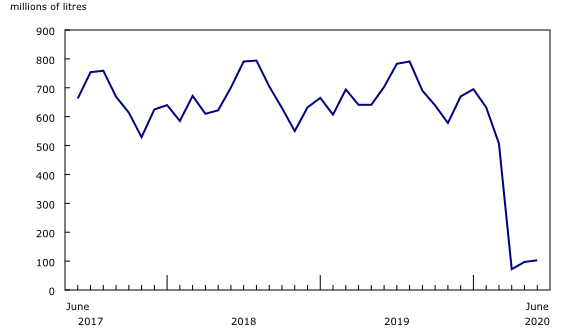Monthly civil aviation statistics, June 2020
Archived Content
Information identified as archived is provided for reference, research or recordkeeping purposes. It is not subject to the Government of Canada Web Standards and has not been altered or updated since it was archived. Please "contact us" to request a format other than those available.
Released: 2020-08-27
Highlights
After two disastrous months for aviation in Canada and around the world, key operating metrics showed some signs of recovery in June—the third full month with travel restrictions in effect to fight the spread of COVID-19.
Although major Canadian airlines carried 440,000 passengers on scheduled and charter services in June, down 93.9% from the same month in 2019, this represents a mild uptick from the year-over-year declines observed in April (-97.0%) and May (-96.7%). On a monthly basis, these airlines carried almost twice as many passengers (+96.2% more) in June 2020 as in May 2020.
Compared with June 2019, air traffic plunged to 885.4 million passenger-kilometres, pushing operating revenues down 90.2% to $221.2 million in June.
Passenger load factor—the ratio of passenger-kilometres to available seat-kilometres—was 45.8% in June, almost half of what it was in June 2019. Since 2015, this ratio had remained near or above 80.0% until falling to a low of 26.0% in April.
Challenging times continue as effects of virus linger
The International Air Transport Association has revised its forecast and now predicts that a return to 2019 levels may not occur until 2024 based on three reasons. First, some countries are struggling to limit the spread of the virus. Second, there has been a reduction in business-related travel because of businesses' financial difficulties, as well as a widespread adoption of video conferencing software during the pandemic. Third, there is weak consumer confidence resulting from both fear of catching the virus while travelling and economic uncertainty.
Despite this pessimistic outlook, some airlines in Europe have reported a stronger than expected increase in demand following the lifting of lockdown measures and the relaxation of travel restrictions. In Canada, where border restrictions and mandatory quarantines remain in effect for international travel and for some interprovincial travel, the recovery progressed slowly in June. Several air carriers have repeatedly postponed their planned dates for restarting their operations.
Passenger demand shows early signs of recovery
The seven Canadian Level I air carriers flew 440,000 passengers on scheduled and charter services in June, down 93.9% from the same month in 2019, when there were six carriers. This marked the fourth consecutive year-over-year monthly decline—a period with the sharpest and deepest drop in passengers carried ever experienced by Canadian aviation.
Year over year, the decline in June was less severe than those recorded in April (-97.0%) and May (-96.7%), as the total passenger volume began to increase.
Airline operating revenue totalled $221.2 million in June, down from $2.3 billion (-90.2%) the same month a year earlier.
Traffic fell 95.6% year over year to 885.4 million passenger-kilometres in June, while capacity contracted 91.8% to 1.9 billion available seat-kilometres. As a result, the passenger load factor in June dropped to 45.8%, down significantly from June 2019 (86.3%), but much improved from April (26.0%) and May (34.1%) of this year. With far fewer international flights available, each passenger travelled an average of 2,012 kilometres in June, down 28.6% from June 2019.
As the number of flying hours fell 88.3% to 22,000 in June, the volume of turbo fuel consumed declined 85.3% to 103.3 million litres.
First half of 2020 posts sharp declines compared with previous years
The severity and abruptness of the impact of the COVID-19 pandemic on the major Canadian airlines are very apparent.
In the first six months of 2020, Canadian Level I air carriers transported 19.1 million passengers—54.8% less than over the same period of 2019—marking a sudden end to the upward trend recorded over the previous five years.
Similarly, traffic from January to June fell to 48.4 billion passenger-kilometres in 2020, 56.6% lower than the same period last year, while capacity was down 50.8% to 65.2 billion available seat-kilometres.
Canadian Level I air carriers flew 48.7% fewer hours in the first six months of 2020 and generated 52.3% less operating revenue than in the same period of 2019.
Note to readers
The Monthly Civil Aviation Survey covers all Canadian Level I air carriers: Air Canada (including Air Canada Rouge), Air Transat, Jazz, Porter, Sky Regional, Sunwing and WestJet (including Swoop, WestJet Encore and WestJet Link).
The number of air carriers increased from six in 2019 to seven in 2020, as one Level II air carrier was reclassified to Level I.
The average passenger trip length is obtained by dividing the number of passenger-kilometres by the number of passengers. Trips across Canada and the world are included in this calculation.
Data in this monthly release are not seasonally adjusted.
Data for July 2019 have been revised.
Contact information
For more information, or to enquire about the concepts, methods or data quality of this release, contact us (toll-free 1-800-263-1136; 514-283-8300; STATCAN.infostats-infostats.STATCAN@canada.ca) or Media Relations (613-951-4636; STATCAN.mediahotline-ligneinfomedias.STATCAN@canada.ca).
- Date modified:







